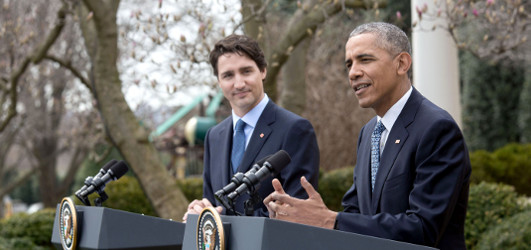Today U.S. President Barack Obama, Canadian Prime Minister Justin Trudeau and Mexican President Enrique Peña Nieto are expected to announce a new continent-wide goal for the three nations to get 50% of their electricity from what they describe as “clean” sources by 2025.
A fact sheet put out by the White House clarifies that this means renewable energy, nuclear power and carbon capture and storage technology, which has not been effectively commercialized at this time. Additionally, the White House has stated that energy efficiency will be a component of the agreement.
The use of the term “clean” to include other sources of low-carbon power than renewable energy has been a trend in the United States, and Mexico’s reform of its energy sector has given a larger role to natural gas as a “clean” energy source, despite concerns about leaks of methane, a very potent greenhouse gas.
The White House has not gone into much detail about how it plans to reach this goal, however it does mention a “range of initiatives”. These including 5 gigawatts of cross-border transmission projects, a joint study of the opportunities and impacts of adding more renewable energy to the grid on a continental basis and a moving of government operations to 100% “clean” energy by that date.
Even with the inclusion of nuclear power, which currently provides around 21% of U.S. electricity, these goals are more aggressive than those that President Obama has announced to date. They are also roughly in line with Democratic Presidential Candidate Hillary Clinton’s plan to move the United States to 33% of its electricity from renewable energy by 2027.
And while some environmentalists may be alarmed at the inclusion of nuclear, nuclear power’s share of total generation is likely to be lower by 2025. Despite ongoing federal support, only five nuclear reactors have begun construction in the United States in recent decades, initially largely due to popular opposition and more recently increasingly prohibitive economics.
Meanwhile a large number of nuclear power plants in the United States are closing or threatening to close, due to both an increase in the cost of maintaining nuclear power plants as they age and wholesale market dynamics. Part of the problem that nuclear power is facing is reduced wholesale power prices due to cheap natural gas, solar and wind.
Increasingly, utilities and regulators are recognizing that nuclear power is incompatible with high penetrations of wind and solar, due to the technology’s lack of flexibility. This was cited as one of the reasons in utility Pacific Gas & Electric Company’s proposal to close the last nuclear power plant in California, the Diablo Canyon Power Plant.
Fortunately, there are fewer barriers to the increased penetration of wind and solar. Earlier this month the White House’s Council of Economic Advisors released a report on the technical and economic dimensions of integrating high levels of renewable energy, which dispelled popular myths repeated in the media regarding technical and market issues.
“In the past many energy analysts and academics had argued that the variable nature of (wind and solar) would limit their integration onto the grid,” CEA noted in the report. “As this report demonstrates, though, there are areas with extensive use of renewable energy and many new technologies can help meet the demand for grid management, allowing for high levels of renewable VERS.”
Correction: An earlier version of this article said that 5,000 miles of cross-border transmission was included in the plan. This article was corrected on July 29 at 1:20 PM Eastern Time (U.S.) to state that this is 5,000 MW, not 5,000 miles.
This content is protected by copyright and may not be reused. If you want to cooperate with us and would like to reuse some of our content, please contact: editors@pv-magazine.com.









By submitting this form you agree to pv magazine using your data for the purposes of publishing your comment.
Your personal data will only be disclosed or otherwise transmitted to third parties for the purposes of spam filtering or if this is necessary for technical maintenance of the website. Any other transfer to third parties will not take place unless this is justified on the basis of applicable data protection regulations or if pv magazine is legally obliged to do so.
You may revoke this consent at any time with effect for the future, in which case your personal data will be deleted immediately. Otherwise, your data will be deleted if pv magazine has processed your request or the purpose of data storage is fulfilled.
Further information on data privacy can be found in our Data Protection Policy.